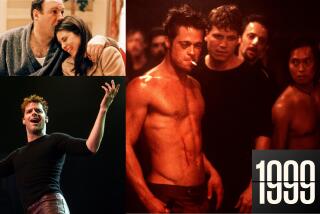Prophecies Ushered Out the 19th Century
News item:
Housing prices in San Francisco soar.
News item:
Gambling condemned in New Orleans.
News item:
Prosperity jitters on Wall Street.
Typical headlines as we end the century, right? But take a squint at the date on those newspapers.
It’s December 1899.
As the 20th century began, those were some of the news stories around the nation. The cost of housing climbed 35% during 1899 in San Francisco; the City Council outlawed slot machines in New Orleans; and the stock market was jumpy over a foreign conflict--the Boer War in Africa, which dominated front pages.
And, oh yes, it was the turn of the century.
Speculation on Global . . . Cooling?
The end of the 20th century has been a yearlong news event, a parade of “best of” lists, predictions and celebratory summaries of the last 100 years. Added to that is all the hoopla over the new millennium and the hullabaloo over possible computer chaos and the Y2K bug.
The newspapers at the end of 1899 were far less preoccupied with the change in the calendar. They offered a mellower reflection of a mellower turn of the century, a time when telephones were new, autos were still a novelty, the Wright brothers were still tethered to the ground--and newspapers were the media of the masses, with more than 2,000 U.S. dailies chronicling everyday life.
That’s not to say the end of one century and the beginning of another went unnoticed.
There were predictions:
A Chicago Daily Tribune story featured scientists speculating about a future in which people’s hands and feet will get smaller because of labor-saving machines, a time when “the hat will vanish and the hair will improve” and when everyone will live around the equator because of . . . global cooling.
“Man will develop more in the 20th century than he has in the last 1,000 years,” one scientist said.
There were “Father Time” cartoons:
The Sunday Herald of Syracuse, N.Y., on Dec. 31, 1899, depicted an elderly gent in a cart-like auto with bicycle-thin tires and “1900” emblazoned on the front, with wing-footed “Progress” striding at his side.
Less Concern With Best-of Lists
And there were editorials:
William Randolph Hearst, the mighty media baron, used the columns of his San Francisco Examiner to put an optimistic spin on the influence of newspapers:
“The 19th century has seen the beginning of the power and usefulness of the press,” he wrote in an end-of-the-year editorial. “The 20th century will see its growth and glory.”
The press, Hearst wrote, “cannot be hired, like a lawyer, to defend wrong or protect evil, for no money can compensate it for the loss of that public support which is its life. Its aims are high, its ethics pure.”
This was the same Hearst who was waging a “penny press” war against Joseph Pulitzer in New York, battling to lure readers with shrieking headlines and sensational stories on everything from scandals to the Spanish-American War.
Like many newspaper editors of that era, they were too wrapped up in the news of the day to spend much time on the turn-of-the-century story. And lists weren’t as important as they are in 1999.
“They weren’t as concerned at looking back at what happened yesterday and last week,” says David Mindich, a journalism professor at St. Michael’s College in Vermont and an expert on 19th century newspapers. “That’s changing now as journalists increasingly see themselves as explainers of history.”
Still, some milestones were noted.
On Dec. 31, 1899, the New York Herald listed “The Three Great Events of the Century”: the digging of the Suez Canal, the laying of the first transatlantic submarine cable, and the battles won in the fight against infectious disease.
On that same day, the Daily Picayune in New Orleans weighed in with a “neat little calendar” assembled by the National American Woman’s Assn. highlighting the progress of women in the 1800s.
It cited major rights gained by women--owning property, participating in lawsuits and attending college.
“Women are now found engaged in almost every line of human activity which, 100 years ago, was closed against them,” the story reported.
Not quite. The right to vote didn’t come for 20 more years.
The San Francisco Examiner offered its own commentary on the status of women.
“Women may work without man, but she can’t enjoy herself without him,” one reporter wrote in a section that summed up the century. “She cannot find the perfect satisfaction in the society of her sex that man can find in his.”
But the writer also reflected on the growing independence of women, noting that in 1850, “the girl of 20 had only one thing to do --marry. Today she has many things to do--and she marries only when she is good and ready.”
Papers Acted as Civic Boosters
The turn of the century was also a time to play civic booster in print.
The San Francisco Chronicle featured a hand-drawn map of the San Francisco Bay area, and celebrated the evolution of the town from mission settlement into a metropolis.
“On the morning of Jan. 1, 1800, the sun rose over a wretched little hamlet, where Spanish priests and Mexican soldiers shared their rations with starving Indians, and blinked in bovine wonderment. . . ,” the newspaper wrote.
And 100 years later?
“The field that opens before San Francisco as a shipping port on the eve of a new century is larger than has ever been revealed to any American port outside of New York.”
On the other side of the country, Pulitzer’s New York Evening World ran its own how-far-we’ve-come story on Jan. 1, 1900.
“Just a hundred years ago this morning, New York City folk were celebrating New Year’s Day in a town of 60,000 inhabitants,” the story read.
The New York Times produced a 32-page financial supplement, which included an optimistic economic assessment: “Prosperity is no fiction, and prosperity should be no peril.”
And smack-dab in the middle of America, William Allen White, who would go on to win the Pulitzer Prize as editor of the Emporia (Kan.) Gazette, was basking in the success of a three-day street fair that fall that was the talk of the town.
The highlight: the first auto that ever crossed the Missouri River, which came from Chicago--shipped free by the Santa Fe Railroad.
In some papers, advertisers tried to stoke excitement about the 20th century.
In Chicago, the Schlesinger and Mayer store ballyhooed a “First Friday of the new century” sale. A Bloomingdale’s ad in New York offered to outfit folks smartly for the new era: “For this business is moving at a 20th century clip.”
A wise shopper could pick up a fur coat for $29, a gold watch for $34.50.
As clocks struck midnight Dec. 31, 1899, so began the 20th century.
Or did it?
The Chicago Daily Tribune ran a cartoon on Jan. 1, 1900, depicting “Father Time” rubbing his bearded chin and wondering: “Is ’99 or ’00 the End? That’s the Question That Has Set Everybody Thinking.”
White, the Emporia Gazette editor, had already made his decision. He ushered in the 20th century with an eloquent editorial in 1901.
“The new century,” he wrote, “will be like the others: Different perhaps in outward semblance, full of some great marvels and what not of scientific toys; but the new century will be as the old at heart and core of it, the gay panorama of life ever moving inexorably restless; stopping for no sorrow, remembering no death.”
And though he noted that all that changes with a new century is the date on letterheads and calendars, he wrote hopefully:
“As the world grows old it learns sense--not rapidly, about as slowly as the hills and rivers grow--and as it learns sense it learns to be kind and thoughtful. About all that has been learned really of importance in the last thousand years is that it pays to be gentle and kind--and only a minority of mankind has learned that.”
Contributing to this report were AP staff members Lukas Alpert in New York City; Mike Hill in Albany, N.Y.; Hadley Pawlak in Buffalo, N.Y.; Brett Martel in New Orleans; Jon Sarche in Denver; John Milburn in Kansas City; Mike Warren and Jessie Seyfer in San Francisco.
More to Read
Sign up for Essential California
The most important California stories and recommendations in your inbox every morning.
You may occasionally receive promotional content from the Los Angeles Times.










